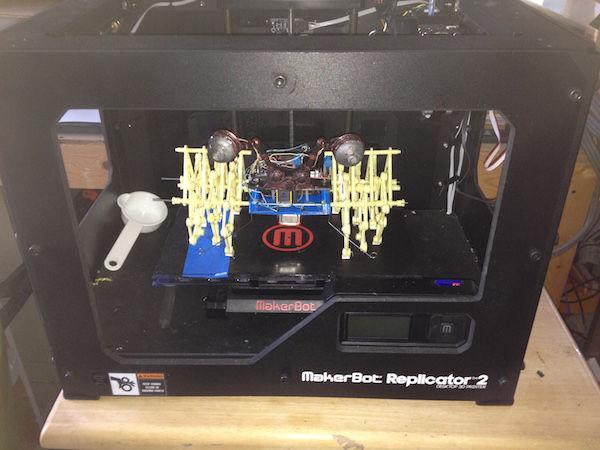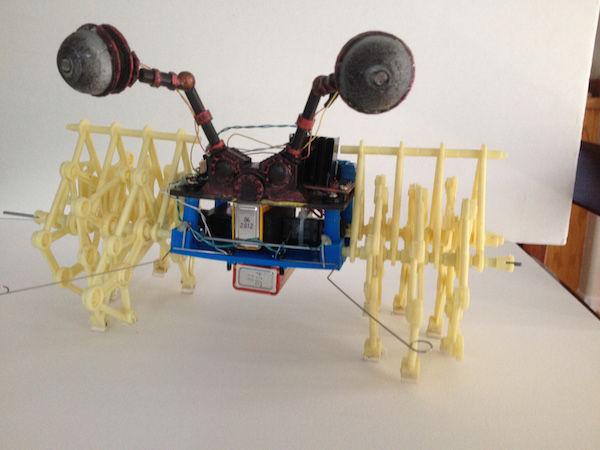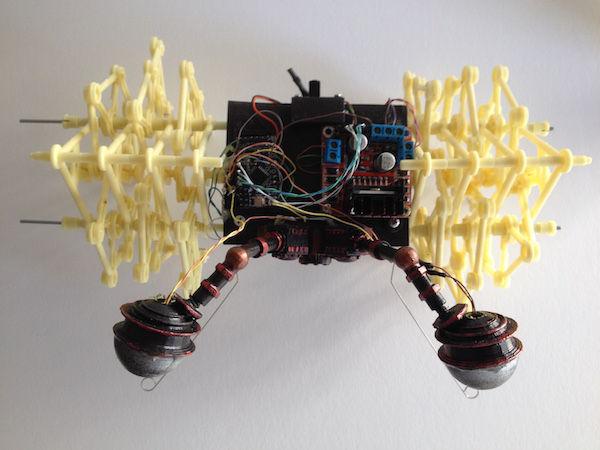 The year is 2015 and 3D printed robots have begun to evolve to a point where they are taking over the world!
The year is 2015 and 3D printed robots have begun to evolve to a point where they are taking over the world!
OK, maybe we aren’t quite there yet. We are not living in a world that is similar to The Terminator films, but we have seen an ever-increasing use of 3D printing in creating custom robots, and if you are a follower of a man named Theo Jansen, you may actually be led to believe that these creatures are beginning to evolve by themselves. Relax though, this isn’t the case, and robots are far from becoming a threat to human beings. However, for one designer, named Charles Ford, 3D printing has allowed him to create quite the unique robot, based on the designs of Theo Jansen.
Ford, who began building BEAM robots ten years ago, has since graduated to creating more complex robotics via advanced technology such as Arduino.
“There has been an explosion of cheap, reliable sensors in the last ten years, and it is total fun to experiment with them,” Ford tells 3DPrint.com. “I received a Makerbot Replicator 2 this winter and am just now learning to create 3D designs and print them.”
For one of his projects, Ford elected to use an idea that he first saw years ago from Theo Jansen and his unique wind-powered beach creature, called the Strandbeest. The creature, which eventually evolved into 3D printed form, has been an inspiration to Ford in this latest endeavor, has garnered much attention among designers worldwide.
“I did some research on the proportions [Jansen] uses to make the leg mechanisms work,” Ford tells us. “I saved drawings and articles, thinking some day I would make a creature. Then I came across an article in Servo magazine that detailed adding motors to a Strandbeest kit available on Ebay. The idea of a light-seeking walking Strandbeest robot popped into my head.”
 Ford isn’t one for throwing good ideas aside, so he set out to create his very own Strandbeest robot. After creating a quick mockup using foam core, bamboo skewers, coffee stir sticks and hot glue, Ford was able to get a good idea of the motor layout that his robot would require. Using SketchUp, he was able to draw up the required pieces.
Ford isn’t one for throwing good ideas aside, so he set out to create his very own Strandbeest robot. After creating a quick mockup using foam core, bamboo skewers, coffee stir sticks and hot glue, Ford was able to get a good idea of the motor layout that his robot would require. Using SketchUp, he was able to draw up the required pieces.
While the leg mechanism is actually part of a kit that Ford purchased, there are several Instructables tutorials on creating your very own 3D printed leg mechanism. He could have easily 3D printed his own leg mechanism, but instead elected to 3D print other parts of the robot.
“The center section where the crankshaft connects to the hacked 9 gram servo motors are attached, and the upper deck with the Arduino, L298N motor controller, and photocell eyes are all 3D printed,” explained Ford. “The robot can walk around the room searching for the brightest light source, avoiding obstacles along the way. The real fun is just watching how the legs work. It is very stable and can traverse rough surfaces easily, but it’s really the motion of the legs that is so fascinating. “
The parts took just a couple hours to 3D print at a layer height of .2mm. As for the electronics used, the robot utilizes a Sparkfun Mini 5 volt Arduino board, with the aforementioned L298N to control the motors. The robot uses sensors that direct it toward the brightest light source, and it features whiskers, similar to those of a cat, that sense if it has run into a wall or other object. When this happens, it automatically backs itself up.
As you can see in the images and videos, this Strandbeest robot has a lot of similarities to Theo Jansen’s original creation, except this one is robotic in nature.
What do you think about this robot? Would you have elected to 3D print the leg mechanism yourself? Discuss in the 3D printed Strandbeest Robot forum thread on 3DPB.com. Check out the video of this robot in action below.
Subscribe to Our Email Newsletter
Stay up-to-date on all the latest news from the 3D printing industry and receive information and offers from third party vendors.
You May Also Like
Precision at the Microscale: UK Researchers Advance Medical Devices with BMF’s 3D Printing Tech
University of Nottingham researchers are using Boston Micro Fabrication‘s (BMF) 3D printing technology to develop medical devices that improve compatibility with human tissue. Funded by a UK grant, this project...
3D Printing Webinar and Event Roundup: April 21, 2024
It’s another busy week of webinars and events, starting with Hannover Messe in Germany and continuing with Metalcasting Congress, Chinaplas, TechBlick’s Innovation Festival, and more. Stratasys continues its advanced training...
3D Printing Webinar and Event Roundup: March 17, 2024
It’s another busy week of webinars and events, including SALMED 2024 and AM Forum in Berlin. Stratasys continues its in-person training and is offering two webinars, ASTM is holding a...
3D Printed Micro Antenna is 15% Smaller and 6X Lighter
Horizon Microtechnologies has achieved success in creating a high-frequency D-Band horn antenna through micro 3D printing. However, this achievement did not rely solely on 3D printing; it involved a combination...































